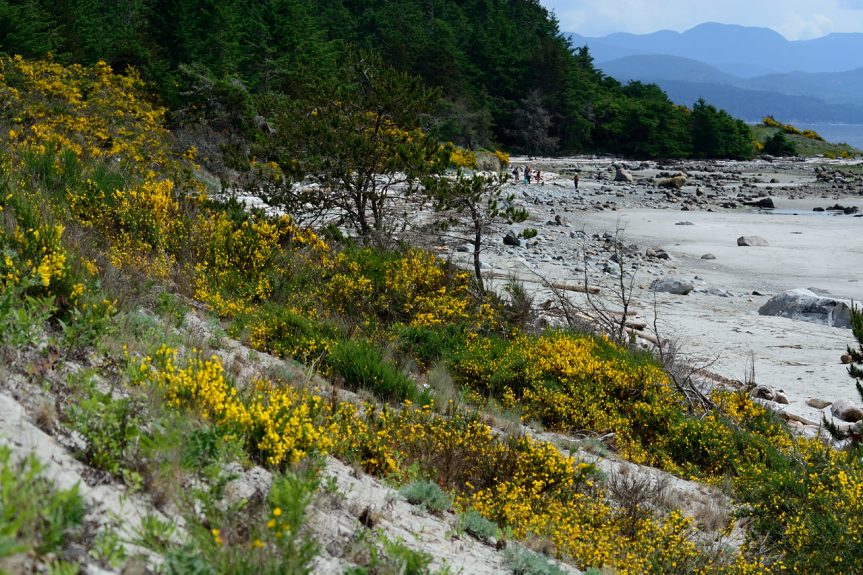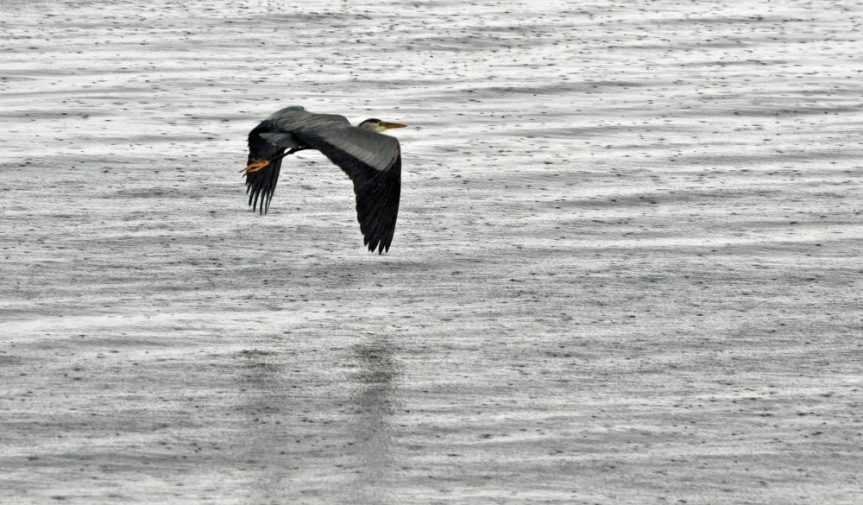
The graceful and instantly recognizable Great blue heron. This one was photographed in Toba Inlet
– M. Glaze

Great blue herons are widespread..
– T. Sohl (sdakotabirds.com)

…but the ‘fannini’ subspecies is smaller and far more localized
– A. Bryant

There are thought to be only about 800-1500 breeding pairs in the Strait of Georgia, although numbers of active nests have fluctuated greatly
– E-Fauna (efauna.bc.ca)

Herons nest colonially, but sites with more than 10 pairs are extremely rare in BC
– H. Domke (ptgardarden.org)

This is one of the local Powell River colonies, with 7 nests. No activity yet this year (as of 2 March)
– A. Bryant

There is some evidence that suggests recent reductions in nest productivity. There are probable multiple issues happening, including habitat degredation and predation
– A. Bryant

The wonderful, iconic, brooding seashore sentinal of BC
– A. Bryant
Tamsin Baker – “Herons and Dunes”
by Andrew Bryant, 26 Feb 2015.
Tamsin Baker holds degrees in Animal Ecology (from UBC) and Environmental Management (from Royal Roads). She presently serves as Stewardship Coordinator with the South Coast Conservation Program, which is a portal that connects small, local, project-oriented groups with governments and scientific researchers. Yes, and they arrange to talk to naturalist clubs too! Accordingly, Tamsin visited Powell River to discuss two projects with which she is involved.
First she spoke about Great Blue Herons in our area, providing an overview of their taxonomy (we mostly see the smaller, coastal Ardea herodias fannini subspecies here), nesting behavior, distribution, population trends, and threats to them. Herons are a good example of how different branches of government deal with threatened species, so we learned about their status both provincially, federally (COSEWIC and SARA), and internationally.
In particular, Tamsin stressed the importance of ongoing, local monitoring efforts of particular nests or nest-colonies in order to provide researchers and governments with accurate information about what is happening “on the ground”. The Heron Working Group can be found here, guidelines for surveying and monitoring heron nests can be found here, and you can view an interactive map of heron nests using the British Columbia Great Blue Herons Atlas, which is part of the wonderful Community Mapping Network.

Coastal sand dune ecosystems require particular geological and oceanic conditions in order to form. This is Duck Bay on Savary Island
– A. Bryant

Such ecosystems are rare in British Columbia, and host unusual plant and animal communities
– A. Bryant

Some species are common and easily spotted, like this Gumweed (Grindelia stricta)
– A. Bryant

or this Western Terrestrial Garter Snake (Thamnophis elegans)
– A. Bryant

Some species are quite rare. This is a Silky Beach Pea (Lathyrus littoralis) – found infrequently on Savary Island – C. Brennan photo (www.carlabrennan.com)

This is the endangered Contorted Pod Evening Primrose (Camissonia contorta), known from only eight locations in Canada, including Savary Island. J. Gatten photo (www.naturalestnaturalist.blogspot.ca)

and this is the Island Tiger Moth (Grammia complicata), which was listed as endangered in Canada by COSEWIC in 2013 – and found in only five locations in BC, including Savary Island – UBC photo

These ecosystems face a variety of threats, one of which is Scotch Broom invasion
– A. Bryant
In the second part of her presentation, Tamsin described the intriguing characteristics of coastal sand dune ecosystems, including their requirements for formation (it turns out they need “feeder cliffs”, “accretional features”, and “helpful tides”). She also described their consequently incredibly patchy distribution within the Strait of Georgia, and the wondrous accumulation of botanical and animal marvels that are likely to be seen in our backyard (or at least on Savary) for those who seek to learn when, where and how to look.
An excellent and comprehensive report prepared for the Coastal Sand Dune Recovery Team can be found here, with a shorter, less technical synopsis prepared by the B.C. Government available here.
Thank you Tamsin…for adding even more species to our club’s collective “I’d really like to see one of these and learn more about it” life-list!





































